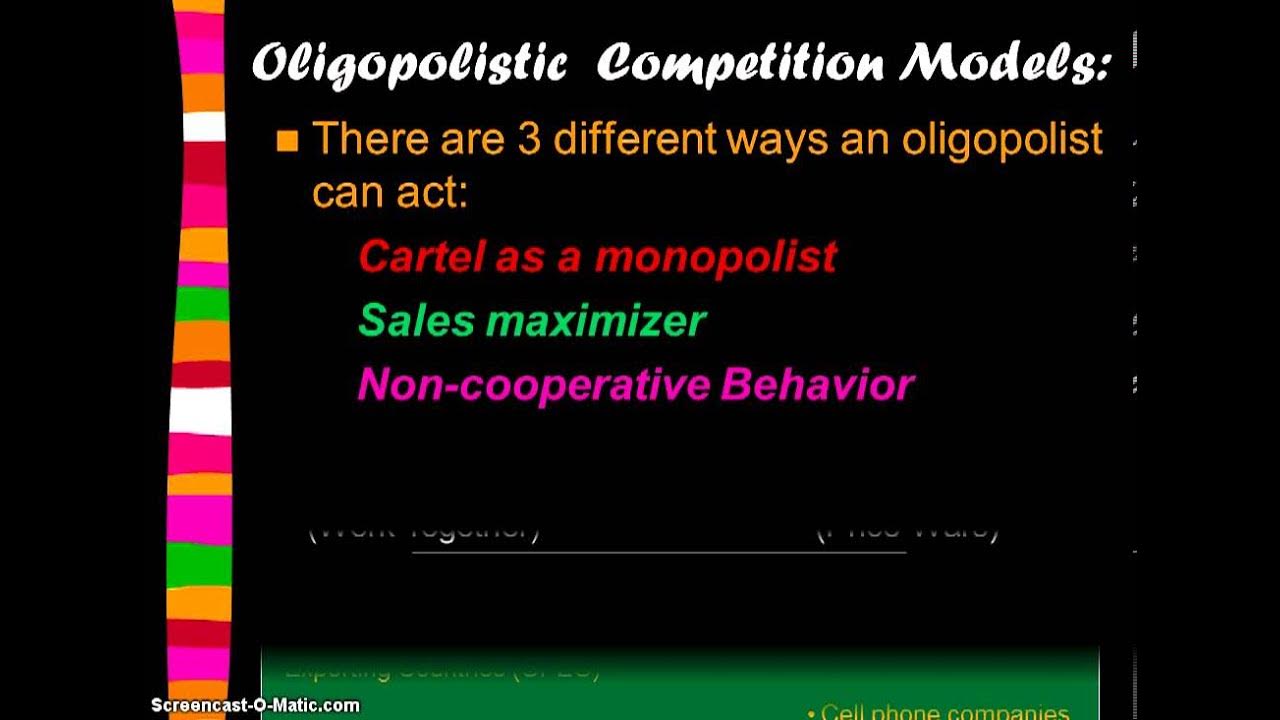Pasar Oligopoli (Oligopoly Market)
Summary
TLDRThis video provides an in-depth look into the characteristics of the oligopoly market, a market structure dominated by a few firms. It explores the key features of oligopolies, such as the number of producers, the type of goods (either differentiated or homogeneous), and their pricing power. The video also discusses barriers to entry, interdependence between firms, and the concept of a kinked demand curve. With examples from industries like automotive and electronics, it highlights the challenges and opportunities within oligopolies, explaining both short-term and long-term outcomes for firms in this market structure.
Takeaways
- 😀 Oligopoly markets are characterized by several producers, with the exact number typically ranging from 2 to 10, although some definitions extend this to as many as 27.
- 😀 Goods in an oligopoly can be either differentiated (e.g., cars or electronics) or homogeneous (e.g., plain A4 paper).
- 😀 Producers in an oligopoly have significant power to set prices, often deviating from the market price to maintain competitive advantage.
- 😀 Entry barriers are high in an oligopoly market, making it difficult for new companies to compete, as significant capital and resources are required.
- 😀 The demand curve in an oligopoly market is broken, meaning that producers’ pricing decisions are interdependent, and changes by one producer trigger reactions from others.
- 😀 In the short term, oligopoly producers can experience supernormal profits, normal profits, or losses, depending on market conditions.
- 😀 In the long term, oligopoly markets are likely to generate supernormal profits, similar to monopolistic markets.
- 😀 Oligopolies rely heavily on the actions and reactions of other firms in the market. Producers' decisions often influence each other.
- 😀 Examples of oligopoly markets include industries like automotive and electronics, where only a few major players dominate the market.
- 😀 Homogeneous goods in an oligopoly (e.g., plain paper) are nearly identical, making it difficult to distinguish between different producers.
Q & A
What is the meaning of the term 'oligopoly'?
-Oligopoly is derived from the Greek words 'oligo' meaning 'several' and 'poly' meaning 'producers.' It refers to a market structure where a few large firms dominate the production of goods or services.
How many producers typically exist in an oligopoly market?
-An oligopoly market typically has a small number of producers, often ranging from 2 to 10. Some may even argue that up to 27 firms could still be considered part of an oligopoly, though it varies by context.
What types of goods are produced in an oligopoly?
-In an oligopoly, the goods can either be differentiated, where products vary slightly between brands, or homogeneous, where the products are nearly identical across brands.
Can you give examples of differentiated goods in an oligopoly market?
-Examples of differentiated goods in an oligopoly market include products like cars, electronics (e.g., smartphones, TVs), and branded appliances, where each brand offers unique features that set it apart from others.
What are homogeneous goods in an oligopoly, and can you provide an example?
-Homogeneous goods in an oligopoly are nearly identical products from different companies. An example would be plain A4 paper, where consumers cannot easily distinguish between different brands due to the similarity of the product.
What does it mean for firms in an oligopoly to have price-setting power?
-Firms in an oligopoly have significant control over setting prices due to the limited competition. Since few firms dominate the market, each firm's pricing decisions can influence the market's overall pricing strategy.
What are barriers to entry in an oligopoly?
-Barriers to entry in an oligopoly are high due to the substantial capital investment, established brand loyalty, and economies of scale that existing firms benefit from. It is difficult for new companies to enter and compete with well-established firms.
What is the kinked demand curve in an oligopoly market?
-The kinked demand curve in an oligopoly is a unique demand curve that is not smooth. It reflects the interdependent nature of firms in the market—if one firm changes its price, others may not follow, leading to a change in market share.
What happens in the short term for firms in an oligopoly market?
-In the short term, firms in an oligopoly can experience varying profits, including supernormal profits, normal profits, or even losses. The specific outcome depends on the firm's pricing strategies and market conditions.
What can we expect in the long term for oligopoly firms?
-In the long term, firms in an oligopoly are likely to earn supernormal profits, similar to a monopoly, due to the limited competition and the high barriers to entry that prevent new firms from entering the market.
Outlines

This section is available to paid users only. Please upgrade to access this part.
Upgrade NowMindmap

This section is available to paid users only. Please upgrade to access this part.
Upgrade NowKeywords

This section is available to paid users only. Please upgrade to access this part.
Upgrade NowHighlights

This section is available to paid users only. Please upgrade to access this part.
Upgrade NowTranscripts

This section is available to paid users only. Please upgrade to access this part.
Upgrade NowBrowse More Related Video

DEFINICION DE OLIGOPOLIO, DUOPOLIO Y MONOPOLIO

PASAR OLIGOPOLI | KELOMPOK 6 | PENGANTAR EKONOMI | MANAJEMEN SEMESTER 1

GROUP 4: OLIGOPOLY | MICROECONOMICS PPT VIDEO PRESENTATION

Estruturas de Mercado: Concorrência Perfeita, Monopólio e Oligopólio

Y2 23) Oligopoly - Kinked Demand Curve

Unit 5 Topic 6: Oligopoly (Part 1)
5.0 / 5 (0 votes)